Louis Pasteur, a French scientist was the first to report the role of microorganisms in fermentation in 1848. Though a trained chemist, Pasteur was also one of the first scientists to recognize the significance of optical isomers, and he emerged one of the greatest biologists of the 19th century.
Louis Pasteur achieved distinction in organic chemistry for his discovery that tartaric acid (a four-carbon organic compound) forms two different types of crystals. He showed that pebrine disease of silkworm was caused by a protozoan parasite. In 1857, he unraveled the mystery of sour wine and showed that bacteria were responsible for the spoilage of wine and other food products.
Louis Pasteur demonstrated that alcoholic fermentations were as a result of microbial activity, and that some microorganisms could decrease alcohol yield and sour the product, and that some fermentations were aerobic while others where anaerobic. Pasteur also developed the process of pasteurization to preserve wine during storage by showing that mid-heating of milk could kill microorganisms in broth. Pasteur firmly disproved the doctrine of spontaneous generation by his swan-necked flask experiment.
He isolated the causative agents of cholera and rabies and subsequently developed vaccines for rabies, cholera, chickenpox and anthrax. Louis Pasteur also proposed germ theory of disease and he also discovered the existence of life in the absence of free oxygen (anaerobic growth). His breakthroughs in microbiology helped solidify the concept of the germ theory of disease, whose principles were being developed at about this time by Robert Hooke and others.
Pasteur in 1880 developed a method of weakening a virulent pathogen, and using same to immunize individuals. His work established the roadmap for inoculating people with attenuated microorganisms as a way of protecting them from diseases caused by specific microorganisms.
References
Barrett J.T (1998). Microbiology and Immunology Concepts. Philadelphia, PA: Lippincott-Raven Publishers. USA.
Beck R.W (2000). A chronology of microbiology in historical context. Washington, D.C.: ASM Press.
Brooks G.F., Butel J.S and Morse S.A (2004). Medical Microbiology, 23rd edition. McGraw Hill Publishers. USA. Pp. 248-260.
Chung K.T, Stevens Jr., S.E and Ferris D.H (1995). A chronology of events and pioneers of microbiology. SIM News, 45(1):3–13.
Slonczewski J.L, Foster J.W and Gillen K.M (2011). Microbiology: An Evolving Science. Second edition. W.W. Norton and Company, Inc, New York, USA.
Summers W.C (2000). History of microbiology. In Encyclopedia of microbiology, vol. 2, J. Lederberg, editor, 677–97. San Diego: Academic Press.
Talaro, Kathleen P (2005). Foundations in Microbiology. 5th edition. McGraw-Hill Companies Inc., New York, USA.
Wainwright M (2003). An Alternative View of the Early History of Microbiology. Advances in applied microbiology. Advances in Applied Microbiology, 52:333–355.
Willey J.M, Sherwood L.M and Woolverton C.J (2008). Harley and Klein’s Microbiology. 7th ed. McGraw-Hill Higher Education, USA.
Discover more from #1 Microbiology Resource Hub
Subscribe to get the latest posts to your email.



